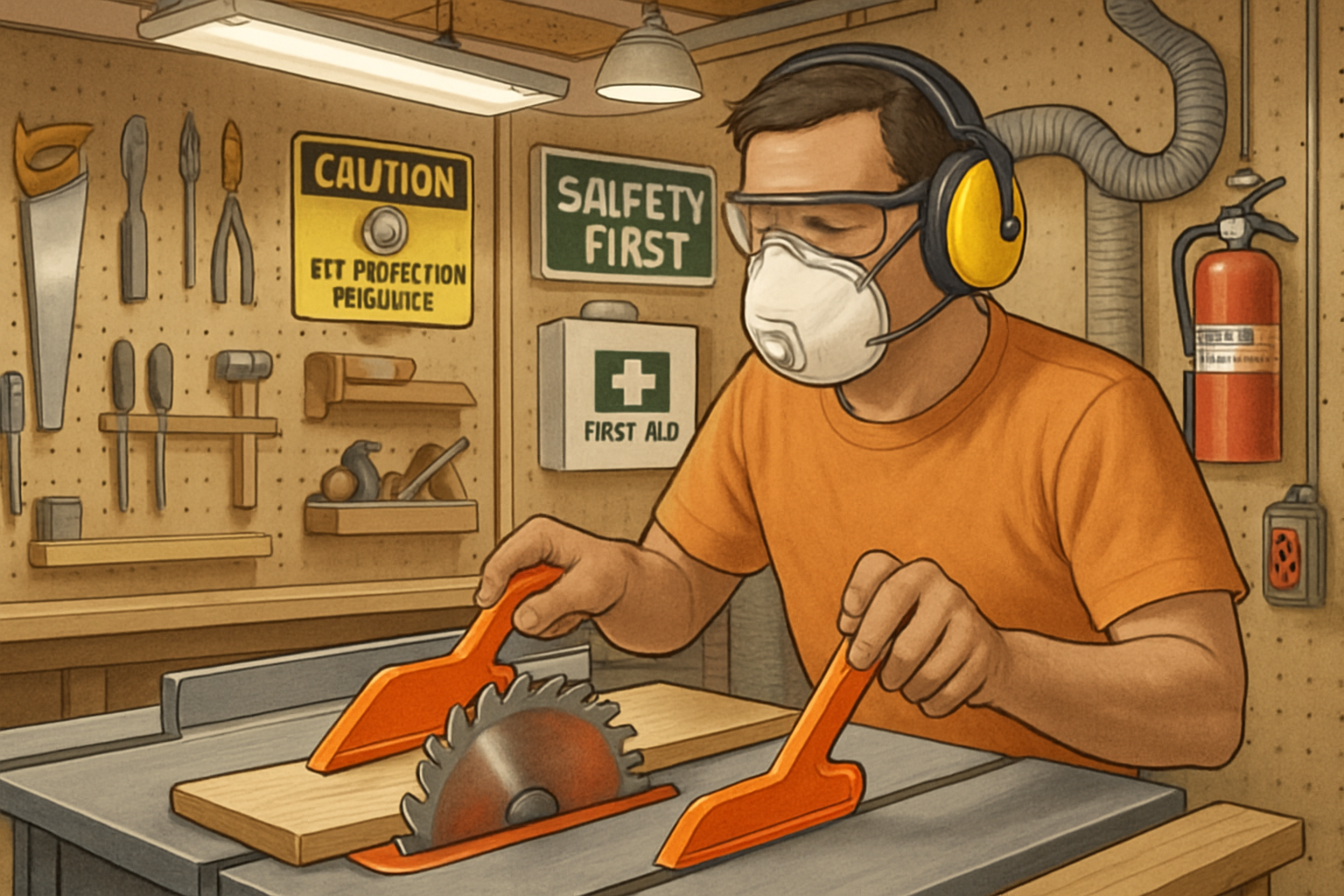Blog
The Ultimate Guide to Woodworking Safety Practices: Protecting Yourself in the Workshop

Stepping into a woodworking shop without understanding safety protocols is like jumping into the deep end without knowing how to swim. I’ve learned this the hard way through years of working with wood. The Ultimate Guide to Woodworking Safety Practices isn’t just about avoiding accidents—it’s about creating habits that let you enjoy this craft for decades to come.
Why Woodworking Safety Should Be Your Top Priority
Every year, thousands of woodworkers end up in emergency rooms with injuries that could have been prevented. I started woodworking as a teenager in my grandfather’s shop, and his first lesson wasn’t about making a perfect joint—it was about keeping all my fingers intact. The confidence that comes from knowing you’re working safely actually improves your craftsmanship. When you’re not worried about getting hurt, you can focus entirely on creating beautiful work.
Essential Personal Protective Equipment for Woodworkers
The right gear isn’t optional—it’s your first line of defense against the many hazards in a woodshop. I never start my table saw without first putting on these critical items:
Eye and Face Protection: Your Vision Is Irreplaceable
Wood chips fly at incredible speeds when cutting. I once had a splinter shoot past my face while ripping oak—a stark reminder that safety glasses are non-negotiable. Look for ANSI Z87.1-rated safety glasses that provide side protection as well. For operations like turning or routing, consider a full face shield to protect against larger projectiles.
Respiratory Protection: What You Can’t See Can Hurt You
Wood dust is classified as a carcinogen, particularly hardwoods like oak and mahogany. At minimum, use an N95 respirator for basic operations. For extended sanding or when working with exotic woods, upgrade to a half-mask respirator with P100 filters. I spent years being casual about dust protection until I developed a persistent cough—don’t make the same mistake.
Hearing Protection: Preserve Your Hearing for Life
Most power tools operate at 85-100 decibels—enough to cause permanent hearing damage with prolonged exposure. Earmuffs with a Noise Reduction Rating (NRR) of at least 25dB or earplugs rated at 29dB or higher are essential for protecting your hearing. Remember, hearing loss is cumulative and irreversible.
Creating a Safe Woodworking Environment
Your workspace setup plays a crucial role in preventing accidents. I completely redesigned my shop after a close call with a circular saw and limited space.
Workshop Layout and Organization for Maximum Safety
A cluttered shop is a dangerous shop. Ensure you have adequate space around each machine—typically 3 feet on all sides for safe operation and movement. Position machines so that kickback zones don’t face walkways or other work areas. Keep floors clear of scraps, extension cords, and tools. I use a simple “clean as you go” rule: no moving to the next operation until the current area is cleaned up.
Proper Lighting: See Clearly, Work Safely
Shadow-free, bright lighting isn’t a luxury—it’s a safety requirement. I recommend a minimum of 50 foot-candles (500 lux) of illumination at workbenches and machinery. Task lighting at specific stations helps prevent eye strain and improves accuracy. My shop has both overhead LED panels and adjustable task lights at each workstation.
Dust Collection: Beyond Cleanliness to Safety
An effective dust collection system reduces fire hazards and protects your lungs. At minimum, use a shop vacuum connected to power tools. For serious woodworking, invest in a central dust collection system with proper filtration (1 micron or better). Remember to regularly clean areas dust collectors can’t reach, like light fixtures and wall shelves, to prevent dust accumulation.
Power Tool Safety Fundamentals
Each tool in your shop has specific safety protocols, but some principles apply universally. Understanding these fundamentals has saved me from countless potential accidents.
The Table Saw: Respect the King of Workshop Injuries
Table saws cause more woodworking injuries than any other tool. Always use the blade guard and riving knife unless the operation specifically prevents their use. Push sticks and push blocks keep hands away from the blade—I keep several within arm’s reach of my saw. Stand to the side of the blade, never directly behind it, to avoid kickback injuries. Consider investing in models with flesh-detection technology if your budget allows.
Router Safety: Controlling the Cyclone
Routers spin bits at 20,000+ RPM, making them particularly dangerous when mishandled. Always secure your workpiece with clamps—never hold it by hand. Start the router and let it reach full speed before contacting wood, and always move against the rotation of the bit (left to right for handheld routing). I learned this lesson the hard way when a router grabbed a piece and threw it across my shop.
Bandsaw and Circular Saw Precautions
For bandsaws, adjust the blade guide to just above the workpiece height. Never remove material between cuts while the blade is moving. For circular saws, ensure the blade depth is set correctly (just slightly deeper than the material), check that the baseplate is secure, and always let the blade stop completely before setting the saw down.
Hand Tool Safety: Not Risk-Free
Hand tools may seem safer than power tools, but they still require proper technique and respect.
Sharp Tools Are Safer Tools
Counterintuitively, sharp tools are safer because they require less force to use. Learn to properly sharpen chisels, plane irons, and saws. When using edged tools, always cut away from your body and keep your free hand behind the cutting edge. I keep a sharpening station in my shop and touch up edges regularly.
Proper Technique for Hand Tool Use
Secure your work with vises or clamps rather than holding it in your hand while cutting or chiseling. Maintain a stable stance with balanced footing. For chisels and planes, keep your dominant hand on the tool and your non-dominant hand well away from the cutting path.
Chemical Safety in the Workshop
Finishes, adhesives, and solvents introduce chemical hazards that require specific safety measures.
Understanding Finish Hazards and Precautions
Many finishes contain volatile organic compounds (VOCs) that can cause short and long-term health issues. Always apply finishes in well-ventilated areas or use a spray booth with proper ventilation. For oil-based products, remember that oil-soaked rags can spontaneously combust—store them in a sealed metal container or lay them flat to dry completely before disposal.
Safe Storage and Handling of Workshop Chemicals
Store chemicals in their original containers with labels intact. Keep them in metal cabinets away from heat sources and oxidizers. I organize my finishes by type (water-based, oil-based, etc.) and keep a printed safety data sheet (SDS) binder for quick reference in case of accidents.
Emergency Preparedness and First Aid for Woodworkers
Despite the best precautions, accidents can happen. Being prepared can minimize damage and potentially save lives.
Workshop First Aid Kit Essentials
Beyond a standard first aid kit, include items specific to woodworking injuries: eye wash station or bottle, burn treatment supplies, and compression bandages for severe cuts. Post emergency contact numbers prominently. I keep first aid kits at multiple locations in my shop, ensuring one is always within quick reach.
Fire Safety in the Wood Shop
Wood dust, finishes, and electrical equipment create significant fire risks. Install ABC-rated fire extinguishers at shop exits and near high-risk areas. Consider a smoke detection system and, if possible, sprinklers. Develop and practice an evacuation plan, especially if your shop is in an attached garage or basement.
Building Safety Habits and Shop Culture
Safety isn’t just about equipment—it’s about consistent practices and mindset.
The “No Shortcuts” Rule
Commit to never bypassing safety procedures, even for “quick cuts” or “simple operations.” Most accidents happen during routine tasks when vigilance drops. I follow a personal rule: if I’m feeling rushed or frustrated, I step away from the shop until I can work with a clear head.
Teaching Others Safely
If you share your shop or teach others, establish clear safety protocols for everyone. Never assume someone knows proper technique—demonstrate safety measures explicitly. I start every workshop session with a safety briefing, even with experienced woodworkers.
Ergonomics and Long-Term Health Considerations
Woodworking isn’t just about avoiding acute injuries—it’s also about preventing chronic pain and health issues.
Proper Lifting and Material Handling
Wood, especially hardwoods and sheet goods, can be surprisingly heavy. Use proper lifting technique: bend at the knees, keep the back straight, and hold material close to your body. For heavy or awkward materials, use carts, roller stands, or get assistance. My shop has adjustable roller stands positioned strategically to support long boards during machining.
Preventing Repetitive Strain Injuries
Take breaks during repetitive tasks like sanding or routing. Alternate between different types of work to use different muscle groups. Adjust workbench and machine heights to prevent stooping or reaching. I use anti-fatigue mats at all stationary tools and my workbench to reduce leg and back strain during long sessions.
Advanced Safety Technology and Equipment
Modern woodworking benefits from technological advances specifically designed for safety.
Flesh-Detection Technology: Worth the Investment?
Systems like SawStop and similar technologies can detect contact with skin and stop blades in milliseconds, potentially turning a catastrophic injury into a minor nick. While expensive, they provide significant protection against the most serious table saw injuries. I consider this technology one of the best investments I’ve made in my woodworking journey.
Automated Dust Collection and Air Filtration
Modern dust collection systems can be configured to start automatically when tools are powered on. Coupled with air filtration units that remove fine airborne particles, these systems create a significantly healthier workshop environment. I run my air filtration system for an hour after I finish working to clean residual dust from the air.
Conclusion: Safety as a Woodworking Skill
The Ultimate Guide to Woodworking Safety Practices isn’t about limiting creativity or enjoyment—it’s about ensuring you can continue woodworking for years to come. I view safety as a fundamental woodworking skill, just as important as learning to cut a dovetail or apply a finish. By integrating these practices into your workflow, safety becomes second nature, allowing you to focus on the joy of creating with wood while knowing you’ve minimized the risks. Remember, the best woodworkers aren’t just those who create beautiful pieces—they’re the ones who do so safely, day after day, year after year.









